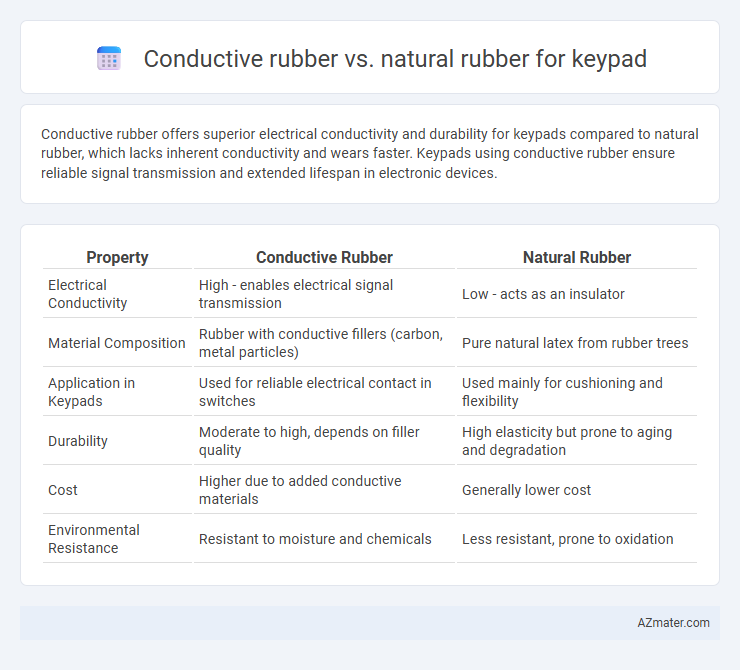Conductive rubber offers superior electrical conductivity and durability for keypads compared to natural rubber, which lacks inherent conductivity and wears faster. Keypads using conductive rubber ensure reliable signal transmission and extended lifespan in electronic devices.
Table of Comparison
| Property | Conductive Rubber | Natural Rubber |
|---|---|---|
| Electrical Conductivity | High - enables electrical signal transmission | Low - acts as an insulator |
| Material Composition | Rubber with conductive fillers (carbon, metal particles) | Pure natural latex from rubber trees |
| Application in Keypads | Used for reliable electrical contact in switches | Used mainly for cushioning and flexibility |
| Durability | Moderate to high, depends on filler quality | High elasticity but prone to aging and degradation |
| Cost | Higher due to added conductive materials | Generally lower cost |
| Environmental Resistance | Resistant to moisture and chemicals | Less resistant, prone to oxidation |
Introduction to Rubber Keypads
Rubber keypads rely on materials like conductive rubber and natural rubber to provide tactile feedback and durability in electronic devices. Conductive rubber contains carbon or metal particles to enable electrical conductivity essential for key actuation, while natural rubber offers elasticity and resilience but lacks inherent conductivity. Selecting the right rubber type directly impacts keypad performance, including sensitivity, longevity, and user experience.
Overview of Conductive Rubber
Conductive rubber used in keypads is a specialized elastomer embedded with conductive materials, such as carbon or metal particles, enabling efficient electrical signal transmission when pressed. This material offers excellent durability, consistent tactile feedback, and reliable performance for electronic interfaces compared to natural rubber, which lacks inherent conductivity. Its tailored electrical and mechanical properties make conductive rubber ideal for responsive and long-lasting keypad applications.
Overview of Natural Rubber
Natural rubber, derived from the latex of Hevea brasiliensis trees, offers excellent elasticity, resilience, and wear resistance, making it suitable for keypad applications requiring durability and comfort. Its inherent flexibility provides responsive tactile feedback essential for user interaction, while its biodegradability positions it as an environmentally friendly material choice compared to synthetic alternatives. Despite lower electrical conductivity than conductive rubber, natural rubber can be enhanced with additives for improved performance in keypad manufacturing.
Electrical Conductivity Comparison
Conductive rubber used in keypads contains carbon or metal particles, enabling electrical conductivity typically ranging from 10 to 10^3 ohm-cm, which allows efficient signal transmission when pressed. Natural rubber is inherently an electrical insulator with resistivity values exceeding 10^12 ohm-cm, making it unsuitable for conductive keypad applications without modification. The enhanced electrical performance of conductive rubber ensures reliable keypad functionality through consistent contact and low resistance pathways, outperforming natural rubber in electronic interface designs.
Durability and Wear Resistance
Conductive rubber for keypads offers superior durability and wear resistance due to its enhanced electrical conductivity and resistance to environmental factors such as moisture and temperature fluctuations. Natural rubber, while flexible and cost-effective, tends to degrade faster under repeated mechanical stress and exposure to oils or UV light, which may lead to loss of conductivity and tactile response. Keypad longevity is significantly improved with conductive rubber materials, making them ideal for high-use applications requiring consistent performance and extended lifespan.
Tactile Feedback and User Experience
Conductive rubber used in keypads offers consistent tactile feedback due to its integrated conductive particles, ensuring reliable electrical contact and precise responsiveness. Natural rubber provides a softer, more elastic feel, enhancing user comfort but potentially compromising the sharpness of tactile feedback critical for efficient keypress recognition. Balancing conductive rubber's durability and uniform feedback with natural rubber's cushioning effect is essential for optimizing overall user experience in keypad design.
Manufacturing Process Differences
Conductive rubber used in keypads incorporates carbon or metal particles during vulcanization to achieve electrical conductivity, requiring precise mixing and curing parameters to maintain consistent resistance levels. Natural rubber, predominantly utilized for its elasticity and durability, undergoes a simpler manufacturing process focused on compounding with fillers and accelerators before vulcanization, without the need for conductive additives. The integration of conductive fillers in conductive rubber demands advanced process control and specialized mixing equipment compared to the more straightforward natural rubber keypad fabrication.
Cost and Availability
Conductive rubber offers cost-effective performance due to its lower material and manufacturing expenses compared to natural rubber, making it ideal for large-scale keypad production. Natural rubber, while more expensive and less conductive, is widely available and favored for its superior elasticity and tactile feedback in high-end keypad applications. Availability of conductive rubber depends on the supply of carbon black or metallic fillers, whereas natural rubber benefits from established global plantations ensuring consistent supply.
Environmental Impact and Sustainability
Conductive rubber used in keypads often contains synthetic materials like carbon or metal particles, which can pose recycling challenges and contribute to environmental pollution. Natural rubber, derived from the latex of rubber trees, offers a renewable and biodegradable alternative that reduces reliance on petroleum-based resources. Utilizing natural rubber promotes sustainability by lowering carbon footprints and supporting eco-friendly manufacturing practices in keypad production.
Applications and Industry Preference
Conductive rubber is preferred in keypad applications requiring reliable electrical conductivity and durability, such as in electronics, automotive controls, and medical devices. Natural rubber, while offering excellent elasticity and tactile feedback, is less favored for conductive keypad components due to its insulating properties and lower wear resistance. Industries prioritize conductive rubber for high-performance keypads where signal transmission and longevity are critical, whereas natural rubber is more common in consumer products emphasizing comfort and cost-effectiveness.

Infographic: Conductive rubber vs Natural rubber for Keypad
 azmater.com
azmater.com